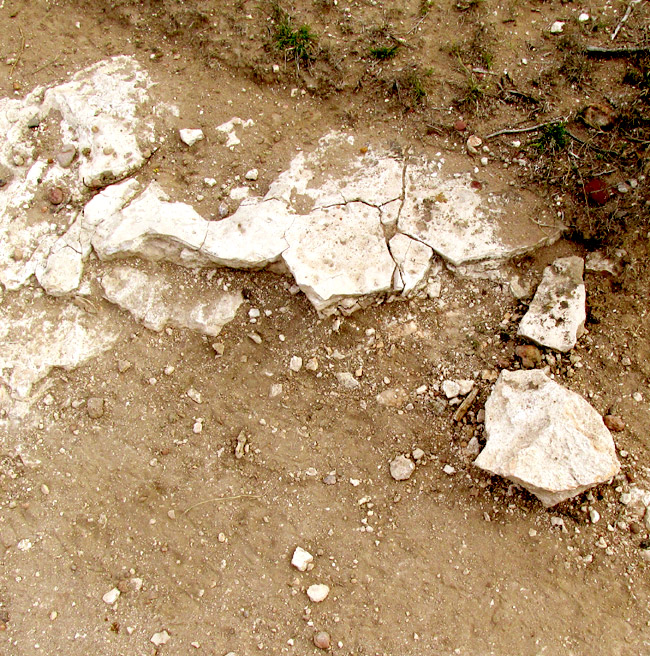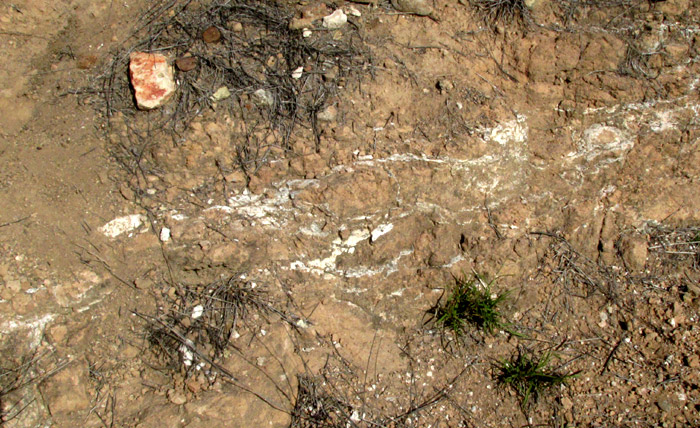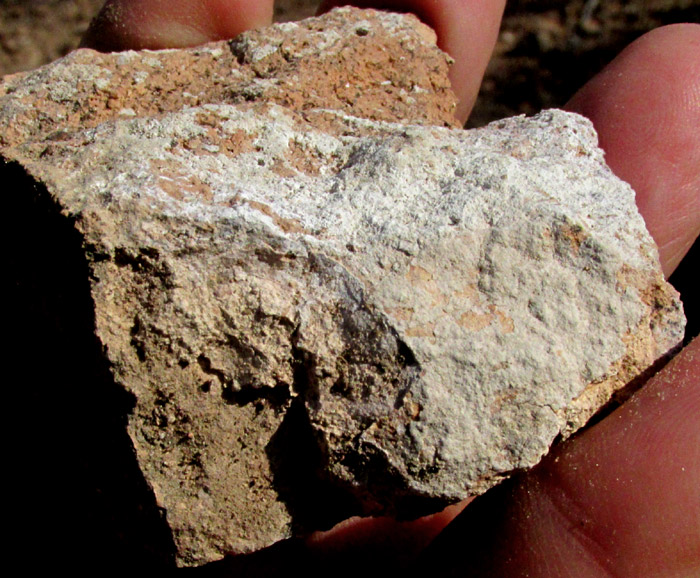Excerpts from Jim Conrad's
Naturalist Newsletter
Entry dated January 4, 2024, issued from near Tequisquiapan; elevation about 1,900m, (6200 ft), ~N20.57°, ~W99.89°; Querétaro state, MÉXICO
TEPETATE (TUFF) WHITE HORIZONS

On the 2007 Mexican Geological Service's Geological-Mining Map, the Carta Geológico-Minera, entitled Tequisquiapan F14-C67 Querétaro e Hidalgo, the late Miocene (~5 million years old) "bedrock" of our area is identified as the TmplTDa type, in Spanish meaning toba dacítica, or dacitic tuff. Dacite is a fine-grained volcanic rock formed by the rapid solidification of lava that is high in silica; it's a transition rock between andesite and the rhyolite of which neighboring extinct volcanoes are formed. Tuff is a relatively soft, porous rock usually formed by the compaction and cementation of volcanic ash or dust. Presumably, the term dacitic tuff means tuff produced by a volcano whose lava hardens into dacite. In Mexico we have lots of tuff, and usually it's called by the Mexican name of tepatate, derived from the Aztecs' Náhuatl language tepétatl. In other countries it has other local names. In English the general name of tuff is used.
In the above picture, the brown dirt is tuff, and particles broken from and eroded from tuff; the white outcrops are what this entry is about. The white outcrops are thin layers usually separated from one another by much thicker brown layers of tepetate, or tuff. The picture shows a spot along a trail traversing a slight incline where, because the white layers are much more resistant to erosion than the tuff, the white layers form a kind of very low stairs with several meters of tuff between them.

Above, the white outcrops appear in a nearly vertical bank of a gully. The white layers are not flat or continual, and are very irregularly embedded amid the tuff, though they do form a distinct, broken horizon. In some places, the white rock surrounds small areas of tuff. Below, a rock of hardened tuff is coated in places with the white material.

In the 2007 work by Jorge Gama-Castro and others entitled "Los tepetates y su dinámica sobre la degradación y el riesgo ambiental: el caso del Glacis de Buenavista, Morelos," I find a picture showing a tuff surface encrusted with white material similar to what's seen above. The authors describe the white covering as a product of the chemical reduction of iron, and washing processes -- procesos de reducción y lavado de hierro.
The chemical reduction of iron consists of altering iron oxides such as rust into the mineral iron at temperatures below iron's melting point. The authors observe that when outcropping tuff forms a gentle slope, salts in the tuff dissolve, are transported, and accumulate at slope bases -- the "washing" process referred to above. Between rains, the concentrated salts, through evaporation, create white deposits atop the sediment. Being dacitic, our tuff contains plagioclase feldspar minerals which can form sodium and calcium salts, which are white.
James Hutton (1726-1797), the "Founder of Modern Geology," formulated the Theory of Uniformitarianism. That insight proposed that past geological processes which created the many different natural features of the world today are still active and will be active in perpetuity. Therefore, today we should see the precipitation of white salts atop drying sediment derived from dacitic tuff:

Above, Chico the Weimaraner dog walks across dark sediment washed into a low spot surrounded by gentle risings composed of tuff, or tepetate. Note the sediment's wide cracks formed by drying during a continuing two-year drought. The sediment is encrusted with white salts. If now a new volcanic eruption covered this area with freshly fallen ash, and this process occurred again and again, eventually the new ash, along with the sediment below it, would be compacted, and might form something like what we see in the above pictures.
Our top pictures show much thicker layers of white stuff than Chico the dog is walking over. Five million years ago when the ash forming our tepetate-tuff fell, the climate would have been different. The 2020 work by María de Jesús Hernández-Hernández and others entitled "Paleoclimatic and vegetation reconstruction of the miocene southern Mexico using fossil flowers," found that the Miocene climate in southern Mexico was hotter and drier than now. If that was also the case here in central Mexico, that climate would have been more conducive to salt precipitation atop drying soils than now.
In southern Querétaro state, closer to the Trans-Mexican Volcanic Belt than here, I've seen quarries with walls two or three stories tall consisting of pure tepetate being cut into blocks and broken into rocks. When the tepetate is less compacted, it can be dug and used as fill dirt. Soil atop tepetate makes awful mud to walk through, sticking to shoes like putty. Walk 10m and you're taller by two finger-widths. It's hard to scrape off with a stick; best to hose it off with a hard stream of water. It dries hard, and if you water a plant growing in it, the water just runs off, unable to penetrate the soil. If water does eventually soak in, it becomes like gravy.